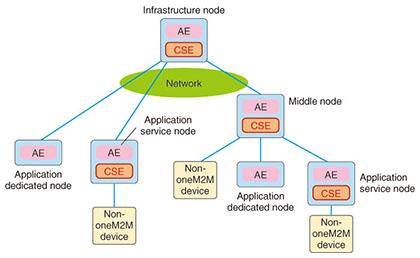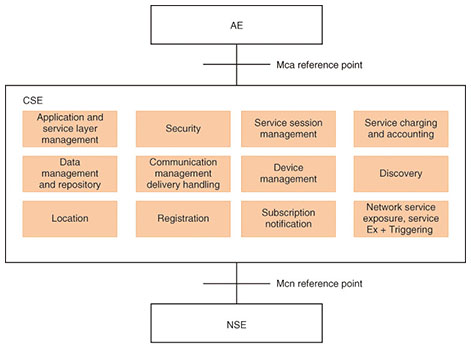 |
|||||||||||||
|
|
|||||||||||||
|
Global Standardization Activities Vol. 12, No. 8, pp. 37–41, Aug. 2014. https://doi.org/10.53829/ntr201408gls Standardization Activities of oneM2MAbstractMachine-to-machine (M2M) services have been developed independently in a diverse range of fields such as industrial machinery and logistics. Demand has been increasing recently for an expansion of the market by building a common M2M platform and using mutual exploitation of M2M data across different industries. In 2012, major regional standards development organizations of Europe, the United States, and Asia established a unified standardization body named ‘oneM2M’ for M2M-associated technologies. This article presents the current status and future activities of oneM2M. Keywords: M2M, standardization, oneM2M 1. IntroductionThe major regional telecommunications standards development organizations (SDOs) established oneM2M in July 2012 in order to develop a set of common technical specifications for machine-to-machine (M2M) technologies. These SDOs are:
These SDOs involved in establishing oneM2M are referred to as Partners Type 1. As of March 2014, through these type-1 SDOs, more than 200 companies had joined oneM2M as Members who are committed to contributing to the development of common specifications. In addition, some industry organizations such as Continua Health Alliance, HGI (Home Gateway Initiative), and OMA (Open Mobile Alliance) have joined oneM2M as Partners Type 2. Members are made up of a majority of the companies that are also ETSI members. This is because ETSI was involved in creating standards for M2M technologies before oneM2M was established. Most Members consist of telecommunications operators and device vendors. The Partners Type 2 are considered to be key players in the dissemination of standards. However, only a few organizations have joined oneM2M as a Partner Type 2, and the industry segments represented by them are limited as of now. Promoting the activities of oneM2M is one of the tasks the Partner Type 2 organizations are required to carry out. The main goal of oneM2M is to create specifications of a common platform for M2M services that have been vertically integrated until now. One of the important benefits of this standardization is reducing the cost of deploying M2M systems by using common hardware and software specifications. Common interface specifications provided by oneM2M will enable various applications to access M2M systems and devices in a uniform way. In addition, various data coming from M2M devices can be distributed across different business fields. This is expected to help enlarge the market associated with M2M. After collecting typical use cases, oneM2M creates M2M technical specifications using a three-step approach: requirements (stage 1), architecture (stage 2), and protocols (stage 3). In addition, security and management technologies for operating M2M platforms safely and reliably are discussed. All of these work items are discussed in working groups (WGs). An organization chart of oneM2M is shown in Fig. 1. The Technical Plenary (TP) is the main body working on technical specifications and consists of five WGs. Each WG primarily handles requirements, architecture, protocols, security, and management. The SC (Steering Committee) deals with strategic issues including budget and IPR (intellectual property rights). In addition, MARCOM (MARketing and COMmunications) was established in order to strengthen marketing activities. Currently, oneM2M is promoting dissemination of its activities.
2. Current activitiesoneM2M initiated technical discussions at its first TP meeting held in September 2012. As of March 2014, nine TP meetings had been held (six times per year). The meeting location rotates between Europe, the USA, and Asia. Some WGs hold teleconferences once a week or every two weeks, and their technical discussions are very active. The status of standardization work is shown in Fig. 2. In the early stage of oneM2M’s establishment, the members planned to issue the first release of specification documents at the end of 2013. However, their work plan was delayed as a result of some exhaustive discussions. Consequently, the first release of the common specifications is expected to be in the middle of 2014. As of April 2014, the technical specifications of the requirements and the associated technical reports had been completed. The architectural work is in the final stage. At the 8th and 9th TP meetings, held respectively in December 2013 and February 2014, many contributions regarding architectural work were discussed and agreed. Moreover, the protocol WG also started technical discussions on protocol specifications.
oneM2M has accelerated standardization activities as mentioned before, and some completed deliverables have been published. The documents of use-case collections and requirements have been approved by a oneM2M TP and have been published by some SDOs. The oneM2M standards release 1 will be approved in the 12th TP meeting scheduled for August 2014. This release is called the minimum deployable model. Further discussion will be required in order to create more practical and detailed specifications. After the first version of specifications is released, oneM2M will continue its standardization work and produce documents using the point release method, which means that specification documents will be released sequentially as soon as they are approved. The following documents will be included in release 1.
At least one of the following documents will also be included.
Finally, at least one of the following documents will be included.
Continua Health Alliance, a Partner Type 2, provided feedback in the form of an analysis of the gap between their own architecture model and a model discussed in oneM2M. However, other Partners Type 2 do not seem to be as actively involved. The expectation is that the first release will trigger greater interest from these partners and other specification users. 3. Overview of architecture specificationsThe basic architecture model discussed in oneM2M is shown in Fig. 3. CSEs (Common Service Entities) are defined as entities located between an AE (Application Entity) and NSE (Network Service Entity). These three basic entities communicate with each other in this model. Generally, M2M services should be deployed on a wide variety of networks, both mobile and fixed. Therefore, detailed technical issues that are specific to the underlying network technologies are avoided in principle. This basic architecture model enables M2M applications to communicate with CSEs implemented in servers, M2M terminal devices, and gateways via reference points (Mca, Mcc, Mcn, and Mcc’ in Fig. 3). CSEs are collections of common functions utilized by various M2M services such as device management. When CSEs are implemented in M2M servers and devices, the M2M applications can easily handle various sensors and actuators. This platform architecture supports installation and separation of applications. It is possible to utilize an M2M device by using different applications independently of each other. Data separation and sharing is also supported between different applications using the appropriate authentication mechanism. The physical components such as M2M servers and devices with CSEs are called nodes. An example structure of a network and M2M nodes is shown in Fig. 4. The CSEs are the key of this architecture model, and they include 12 functions, as shown in Fig. 5. These functions include device discovery, device and application management, data management and repository, and authentication and security associated functions. Completing the protocol specifications for communication between nodes is one of the most important tasks of oneM2M. WG3 is currently discussing this issue. As of June 2014, they had finished analyzing existing protocols related to M2M services. HTTP, CoAP (a lightweight HTTP), and MQTT (a scalable protocol designed for M2M communication), are the presumed standardization targets.
4. Future workoneM2M is accelerating its activities as it prepares to issue the first release of specifications. The first release will, however, provide limited capabilities. Further work will be necessary to produce more detailed and practical specifications that can be utilized for implementation of actual M2M platforms. TP meetings will continue to be held six times per year, and further technical specifications will be released sequentially as soon as they are approved. Global attention on oneM2M is expected to increase when its first set of specifications is released. Reference
|
|||||||||||||







